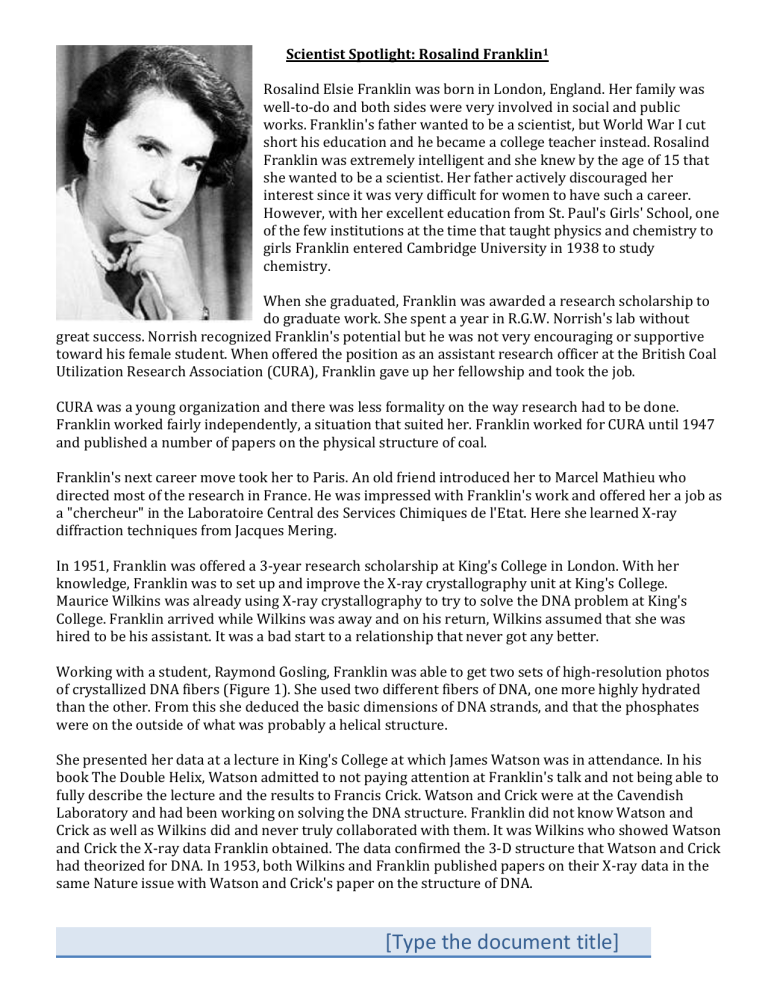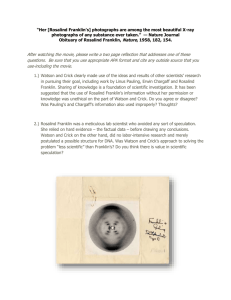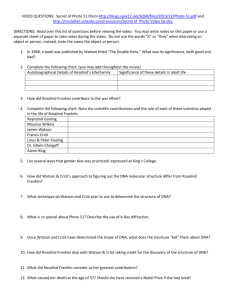
Scientist Spotlight: Rosalind Franklin1 Rosalind Elsie Franklin was born in London, England. Her family was well-to-do and both sides were very involved in social and public works. Franklin's father wanted to be a scientist, but World War I cut short his education and he became a college teacher instead. Rosalind Franklin was extremely intelligent and she knew by the age of 15 that she wanted to be a scientist. Her father actively discouraged her interest since it was very difficult for women to have such a career. However, with her excellent education from St. Paul's Girls' School, one of the few institutions at the time that taught physics and chemistry to girls Franklin entered Cambridge University in 1938 to study chemistry. When she graduated, Franklin was awarded a research scholarship to do graduate work. She spent a year in R.G.W. Norrish's lab without great success. Norrish recognized Franklin's potential but he was not very encouraging or supportive toward his female student. When offered the position as an assistant research officer at the British Coal Utilization Research Association (CURA), Franklin gave up her fellowship and took the job. CURA was a young organization and there was less formality on the way research had to be done. Franklin worked fairly independently, a situation that suited her. Franklin worked for CURA until 1947 and published a number of papers on the physical structure of coal. Franklin's next career move took her to Paris. An old friend introduced her to Marcel Mathieu who directed most of the research in France. He was impressed with Franklin's work and offered her a job as a "chercheur" in the Laboratoire Central des Services Chimiques de l'Etat. Here she learned X-ray diffraction techniques from Jacques Mering. In 1951, Franklin was offered a 3-year research scholarship at King's College in London. With her knowledge, Franklin was to set up and improve the X-ray crystallography unit at King's College. Maurice Wilkins was already using X-ray crystallography to try to solve the DNA problem at King's College. Franklin arrived while Wilkins was away and on his return, Wilkins assumed that she was hired to be his assistant. It was a bad start to a relationship that never got any better. Working with a student, Raymond Gosling, Franklin was able to get two sets of high-resolution photos of crystallized DNA fibers (Figure 1). She used two different fibers of DNA, one more highly hydrated than the other. From this she deduced the basic dimensions of DNA strands, and that the phosphates were on the outside of what was probably a helical structure. She presented her data at a lecture in King's College at which James Watson was in attendance. In his book The Double Helix, Watson admitted to not paying attention at Franklin's talk and not being able to fully describe the lecture and the results to Francis Crick. Watson and Crick were at the Cavendish Laboratory and had been working on solving the DNA structure. Franklin did not know Watson and Crick as well as Wilkins did and never truly collaborated with them. It was Wilkins who showed Watson and Crick the X-ray data Franklin obtained. The data confirmed the 3-D structure that Watson and Crick had theorized for DNA. In 1953, both Wilkins and Franklin published papers on their X-ray data in the same Nature issue with Watson and Crick's paper on the structure of DNA. [Type the document title] In 1962, the Nobel Prize in Physiology or Medicine was awarded to James Watson, Francis Crick, and Maurice Wilkins for solving the structure of DNA. The Nobel committee does not give posthumous prizes. After King’s College Rosalind Franklin focused her research efforts on viruses and in particular the Tobacco Mosaic Virus (TMV). Her research led her to believe that TMV was a hollow tube of protein. She hypothesized that the RNA of this virus was single-stranded and helical. Her characteristic perfectionism in experimental procedure and technique led to the discovery that the RNA was actually embedded in the proteins and not contained only in the core as expected. The descriptions Franklin provided were incredibly detailed, including the angle of the location of the RNA relative to the axis of the virus. Franklin was passionate about her research and felt that it would lead to a greater understanding of viruses that plagued man. She expanded her research to include the polio virus and a potato virus, but her research was cut short when she developed ovarian cancer. She was extremely frustrated, knowing her work on viruses was not completed. Franklin died in London on April 16, 1958. Her research was presented at the 1958 World's Fair and received the accolades it deserved. Figure 1: X-ray diffraction image of DNA taken by Franklin and Gosling. QUESTIONS TO THINK ABOUT: Is it typical that a single person makes major discoveries in science? Was Rosalind Franklin treated fairly by her peers? Is it easier for women and people of color to carry out scientific research today versus 60 years ago?


